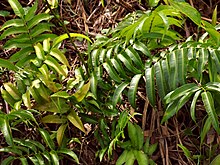Stenochlaena palustris
This article needs more reliable medical references for verification or relies too heavily on primary sources. (August 2015) |  |
| Stenochlaena palustris | |
|---|---|

| |
| Scientific classification | |
| Kingdom: | Plantae |
| Clade: | Tracheophytes |
| Division: | Polypodiophyta |
| Class: | Polypodiopsida |
| Order: | Polypodiales |
| Suborder: | Aspleniineae |
| Family: | Blechnaceae |
| Genus: | Stenochlaena |
| Species: | S. palustris
|
| Binomial name | |
| Stenochlaena palustris | |
Stenochlaena palustris (Vietnamese: choại, Tagalog: dilimán[1] or hagnaya[2]) is an edible medicinal fern species. In the folk medicines of India and Malaysia, the leaves of this fern are used as remedies for fever, skin diseases, ulcers, and stomachache.[3][4]
This plant is a long-climbing fern with thin black scales and stems that can reach up to 20 m. It has pinnate fronds that are 30–100 cm long, petioles that are 7–20 cm long, and ovate lanceolate pinnae that are 10–15 cm long and 1.5–4.5 cm wide. The fern's sporophylls are long and narrow, and have brownish sori underneath.[5]
Acylated flavonol glycosides isolated from the fern were found to have antibacterial activities.[6] Crude and partially purified extracts prepared from the fern have been shown to exhibit antifungal,[7] antioxidant,[8] and antiglucosidase [9] activities.
The district of Diliman in Quezon City, one of the Philippines' most important educational districts, is named after this fern.[10] The species epithet palustris is Latin for "of the marsh" and indicates its common habitat.[11]
Cuisine
[edit]
In the Malaysian state of Sarawak, the plant is called "Midin". It is a popular food among the locals. The young fronds are usually served stir-fried with garlic, dry shrimps, or Shrimp paste. (Belacan).[12][13] In Sabah, it is called "Lembiding". People usually cook it with sardines or belacan.
In Vietnam, the young fronds are called đọt choại and can be used in soups, salads and some stir fry dishes, especially with garlic.[citation needed]
References
[edit]- ^ Bulletin. Bureau of Public Printing. 1916. p. 16.
- ^ Aya, Rose Anne M.; Abeleda, Meliza F. (2018-05-07). "Pag-aaral ng 'supply chain' ng pang-komersyal na baging mula sa gubat, isasagawa". www.pcaarrd.dost.gov.ph. Department of Science and Technology - Philippine Council for Agriculture, Aquatic and Natural Resources Research and Development. Archived from the original on 2022-07-11. Retrieved 2022-07-11.
- ^ Compendium of medicinal plants used in Malaysia. 2002, vol 2. Herbal Medicine Research Centre, Institute for Medical Research, Kuala Lumpur, Malaysia.
- ^ Benjamin, A. and V.S. Manickam. 2007. Medicinal pteridophytes from the Western Ghats. Indian Journal of Traditional Knowledge. 6: 611-618.
- ^ Tanaka, Yoshitaka; Van Ke, Nguyen (2007). Edible Wild Plants of Vietnam: The Bountiful Garden. Thailand: Orchid Press. p. 58. ISBN 978-9745240896.
- ^ Liu, H., J. Orjala, O. Sticher, and T. Rali. 1999. Acylated flavonol glycosides from leaves of Stenochlaena palustris. Journal of Natural Products. 62: 70-75.
- ^ Sumathy, V., S. Jothy Lachumy, Z. Zuraini, and S. Sasidharan. 2010. Effects of Stenochlaena palustris leaf extract on growth and morphogenesis of food borne pathogen, Aspergillus niger. Malaysian Journal of Nutrition. 16: 439-446.
- ^ Chai TT, Panirchellvum E, Ong HC, Wong FC (2012) Phenolic contents and antioxidant properties of Stenochlaena palustris, an edible medicinal fern. Botanical Studies 53: 439-446.
- ^ Chai TT, Kwek MT, Ong HC, Wong FC (2015) Water fraction of edible medicinal fern Stenochlaena palustris is a potent α-glucosidase inhibitor with concurrent antioxidant activity. Food Chemistry 186: 26-31.
- ^ "UPDATE MAGAZINE SEPT-DEC 2014". Archived from the original on 2015-07-23. Retrieved 2024-12-15.
- ^ Archibald William Smith A Gardener's Handbook of Plant Names: Their Meanings and Origins, p. 258, at Google Books
- ^ Churchill, Edward (6 April 2018). "Enjoy your midin without fear — Professor". The Borneo Post. Archived from the original on 6 April 2018. Retrieved 29 May 2018.
- ^ Paul P.K., Chai (April 2016). "Midin (Stenochlaena palustris), the popular wild vegetable of Sarawak" (PDF). Agriculture Science Journal. 2 (2). Universiti Tunku Abdul Rahman: 18–20. Archived from the original (PDF) on 2018-05-29. Retrieved 29 May 2018.
